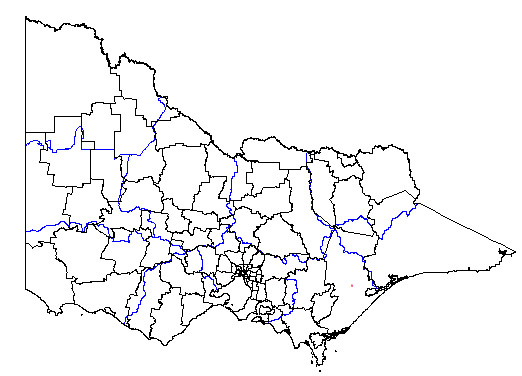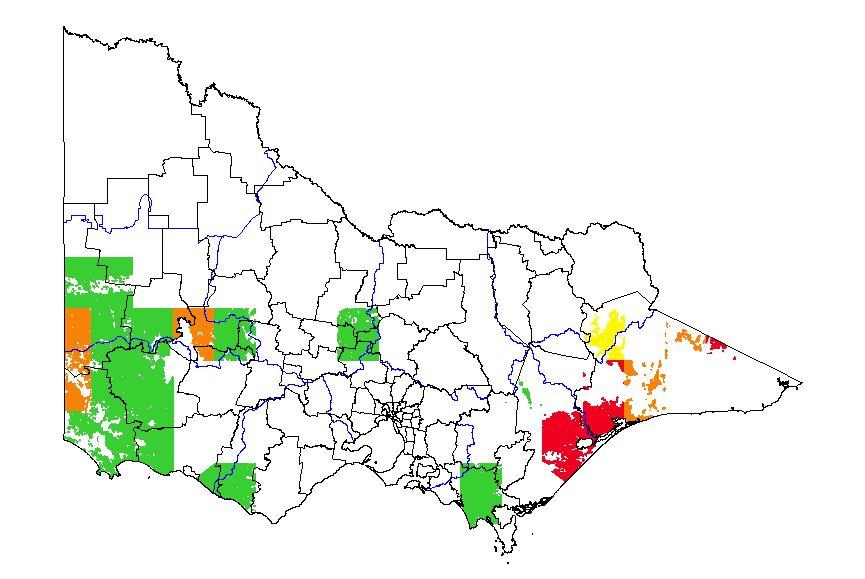Star burr (Acanthospermum hispidum)
Present distribution
|  Map showing the present distribution of this weed. | ||||
| Habitat: The species is reported as primarily an agricultural weed, it may invade cotton, soybean, sugarcane, peanut, tobacco, maize and sorghum crops (Parsons and Cuthbertson 2001). It can also invade pasture and may also be found in other disturbed sites such as creek flats, roadsides and waste places (Parsons and Cuthbertson 2001). | |||||
Potential distribution
Potential distribution produced from CLIMATE modelling refined by applying suitable landuse and vegetation type overlays with CMA boundaries
| Map Overlays Used Land Use: Broadacre cropping; horticulture seasonal; pasture dryland; pasture irrigation Broad vegetation types Basalt grassland; alluvial plains grassland; alluvial plains woodland; riverine woodland/forest; freshwater wetland (ephemeral) Colours indicate possibility of Acanthospermum hispidum infesting these areas. In the non-coloured areas the plant is unlikely to establish as the climate, soil or landuse is not presently suitable. | 
|
Impact
QUESTION | COMMENTS | RATING | CONFIDENCE |
| Social | |||
| 1. Restrict human access? | The species has small spines and can occur in riparian areas (Parsons and Cuthbertson 2001). Therefore the species may have some nuisance value. | ml | mh |
| 2. Reduce tourism? | As the species is most frequently reported by Parsons and Cuthbertson (2001) in disturbed areas this is thought to be unlikely. | l | mh |
| 3. Injurious to people? | The species has spiny seeds (Parsons and Cuthbertson 2001). | mh | mh |
| 4. Damage to cultural sites? | As a annual herb of less than one meter high, that is most frequently reported by Parsons and Cuthbertson (2001) in disturbed areas this is thought to be unlikely. | l | mh |
| Abiotic | |||
| 5. Impact flow? | Terrestrial species. | l | m |
| 6. Impact water quality? | Terrestrial species. | l | m |
| 7. Increase soil erosion? | As the species is most frequently reported by Parsons and Cuthbertson (2001) in disturbed areas this is thought to have very little impact on erosion. | ml | mh |
| 8. Reduce biomass? | As a annual herb of less than one meter high, that is most frequently reported by Parsons and Cuthbertson (2001) in disturbed areas this is thought not to have any significant impact on biomass. | ml | mh |
| 9. Change fire regime? | As a annual herb of less than one meter high, that is most frequently reported by Parsons and Cuthbertson (2001) in disturbed areas this is thought not to have any significant impact on the fire regime. | l | mh |
| Community Habitat | |||
| 10. Impact on composition (a) high value EVC | EVC = Floodplain Riparian Woodland (E); CMA = West Gippsland; Bioregion = Gippsland Plain; VH CLIMATE potential. This species is reported as predominantly an agricultural weed that is most frequent in disturbed sites (Parsons and Cuthbertson 2001). Therefore it is thought to cause very little displacement of indigenous species. | l | mh |
| (b) medium value EVC | EVC =Riverine Escarpment Scrub (R); CMA = East Gippsland; Bioregion = East Gippsland Uplands; VH CLIMATE potential. This species is reported as predominantly an agricultural weed that is most frequent in disturbed sites (Parsons and Cuthbertson 2001). Therefore it is thought to cause very little displacement of indigenous species. | l | mh |
| (c) low value EVC | Climate modelling indicates this species is unlikely to occur in a vulnerable low value EVC. This species is reported as predominantly an agricultural weed that is most frequent in disturbed sites (Parsons and Cuthbertson 2001). Therefore it is thought to cause very little displacement of indigenous species. | l | mh |
| 11. Impact on structure? | This species is reported as predominantly an agricultural weed that is most frequent in disturbed sites (Parsons and Cuthbertson 2001). Therefore it is thought to cause very little impact on vegetation structure. | l | mh |
| 12. Effect on threatened flora? | This species is reported as predominantly an agricultural weed that is most frequent in disturbed sites (Parsons and Cuthbertson 2001). Therefore it is thought to cause very little impact on threatened flora. | l | mh |
| Fauna | |||
| 13. Effect on threatened fauna? | This species is reported as predominantly an agricultural weed that is most frequent in disturbed sites (Parsons and Cuthbertson 2001). Therefore it is thought to cause very little impact on threatened fauna. | l | m |
| 14. Effect on non-threatened fauna? | This species is reported as predominantly an agricultural weed that is most frequent in disturbed sites (Parsons and Cuthbertson 2001). Therefore it is thought to cause very little impact on fauna. | l | m |
| 15. Benefits fauna? | The species is a spiny herb of less than 1m high (Parsons and Cuthbertson 2001). The species is reported to be avoided by browsing species (Miller et al. 1963). Therefore the species is considered unlikely to provide much in the way of support to desirable species. | h | mh |
| 16. Injurious to fauna? | The species could possible cause nitrate poisoning if browsed (Parsons and Cuthbertson 2001). This is yet to be proven in the field however. | m | l |
| Pest Animal | |||
| 17. Food source to pests? | The species is reported to be avoided by browsing species (Miller et al. 1963). Therefore the species is considered unlikely to provide much in the way of support to pest species. | l | h |
| 18. Provides harbor? | The species is a spiny herb of less than 1m high (Parsons and Cuthbertson 2001). Therefore the species is considered unlikely to provide much in the way of support to pest species. | l | mh |
| Agriculture | |||
| 19. Impact yield? | The species is recorded reducing the yield of peanut crops by more than 20% in Florida (Parsons and Cuthbertson 2001). The species is also reported to impact upon tobacco, maize, sorghum, cotton and pasture both through reducing pasture yield as well as stock access (Parsons and Cuthbertson 2001). | h | mh |
| 20. Impact quality? | The species is reported to be a significant contaminant of wool as the burr can’t be removed mechanically instead needs a more costly treatment of acid carbonising (Parsons and Cuthbertson 2001). The species is also a contaminant of fodder, the burrs can cause lameness of stock and browsing of the plant may result in nitrate poisoning (Parsons and Cuthbertson 2001). | mh | mh |
| 21. Affect land value? | Unknown. | m | l |
| 22. Change land use? | A suggested control measure is to plough in the seed to a depth of more than 10cm and then sow a perennial pasture (Parsons and Cuthbertson 2001). This may result in a decrease in agricultural return with a shift from broad acre cropping to pasture. | m | l |
| 23. Increase harvest costs? | The species is reported to impede harvesting (Parsons and Cuthbertson 2001). Unknown to what extent | m | l |
| 24. Disease host/vector? | The species is an alternate host of Calidea dregii and insect pest of cotton and the wilt causing pathogen Verticillium albo-atrum (Parsons and Cuthbertson 2001). | m | mh |
Invasive
QUESTION | COMMENTS | RATING | CONFIDENCE |
| Establishment | |||
| 1. Germination requirements? | Germinates in spring and into early summer (Parsons and Cuthbertson 2001). Therefore the species has a seasonal requirement. | mh | mh |
| 2. Establishment requirements? | Sensitive to shade the species appears to require bare ground and sufficient moisture to establish (Parsons and Cuthbertson 2001). | ml | mh |
| 3. How much disturbance is required? | The species is reported to be a problem in crops and pasture (Parsons and Cuthbertson 2001). | mh | mh |
| Growth/Competitive | |||
| 4. Life form? | Other; Erect annual herb (Parsons and Cuthbertson 2001). | l | mh |
| 5. Allelopathic properties? | There is no evidence of this reported. | l | m |
| 6. Tolerates herb pressure? | Reported to be browsed by livestock (Mwalyosi 2000). Due to the spiny nature of the seeds the species is avoided by livestock, even after being processed as silage only small quantities were consumed (Miller et al. 1963). | h | h |
| 7. Normal growth rate? | Can grow to 90cm within a couple of months (Parsons and Cuthbertson 2001). Therefore the species is thought to have a growth rate equal to that of other competitive annual herbs. | mh | mh |
| 8. Stress tolerance to frost, drought, w/logg, sal. etc? | Unknown. | m | l |
| Reproduction | |||
| 9. Reproductive system | The species reproduces sexually producing seed (Parsons and Cuthbertson 2001). | ml | mh |
| 10. Number of propagules produced? | Average seed production is more than 2000 seeds per plant (Parsons and Cuthbertson 2001). | h | mh |
| 11. Propagule longevity? | If not buried deep seeds have been found to remain viable for 8 years (Parsons and Cuthbertson 2001). | ml | mh |
| 12. Reproductive period? | Annual species (Parsons and Cuthbertson 2001). | l | mh |
| 13. Time to reproductive maturity? | Under two months (Parsons and Cuthbertson 2001). | h | mh |
| Dispersal | |||
| 14. Number of mechanisms? | Seed is dispersed externally on animals, by water, and accidentally by people on clothes and in contaminated hay and other fodder (Parsons and Cuthbertson 2001). | mh | mh |
| 15. How far do they disperse? | Seed can be transported long distances by flood waters and stock movement (Parsons and Cuthbertson 2001). It is likely that seeds will be dispersed greater than 1km. | h | mh |
References
Miller TB, Rains AB, Thorpe RJ (1963) The nutritive value and agronomic aspects of some fodders in northern Nigeria. Grass and Forage Science 18, 223-229.
Mwalyosi BB (2000) Vegetation changes following land reclamation in the Konoa Eroded Area, central Tanzania. African Journal of Ecology 38, 265-268.
Parsons WT, Cuthbertson EG (2001) Noxious weeds of Australia, 2nd ed., CSIRO Publishing, Collingwood.
Global present distribution data references
Australian National Herbarium (ANH) (2008) Australia’s Virtual Herbarium, Australian National Herbarium, Centre for Plant Diversity and Research, Available at http://www.anbg.gov.au/avh/ (verified 4 March 2008).
Global Biodiversity Information Facility (GBIF) (2008) Global biodiversity information facility, Available at http://www.gbif.org/ (verified 14 February 2008).
Feedback
Do you have additional information about this plant that will improve the quality of the assessment?
If so, we would value your contribution. Click on the link to go to the feedback form.


